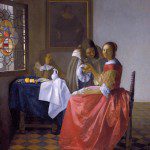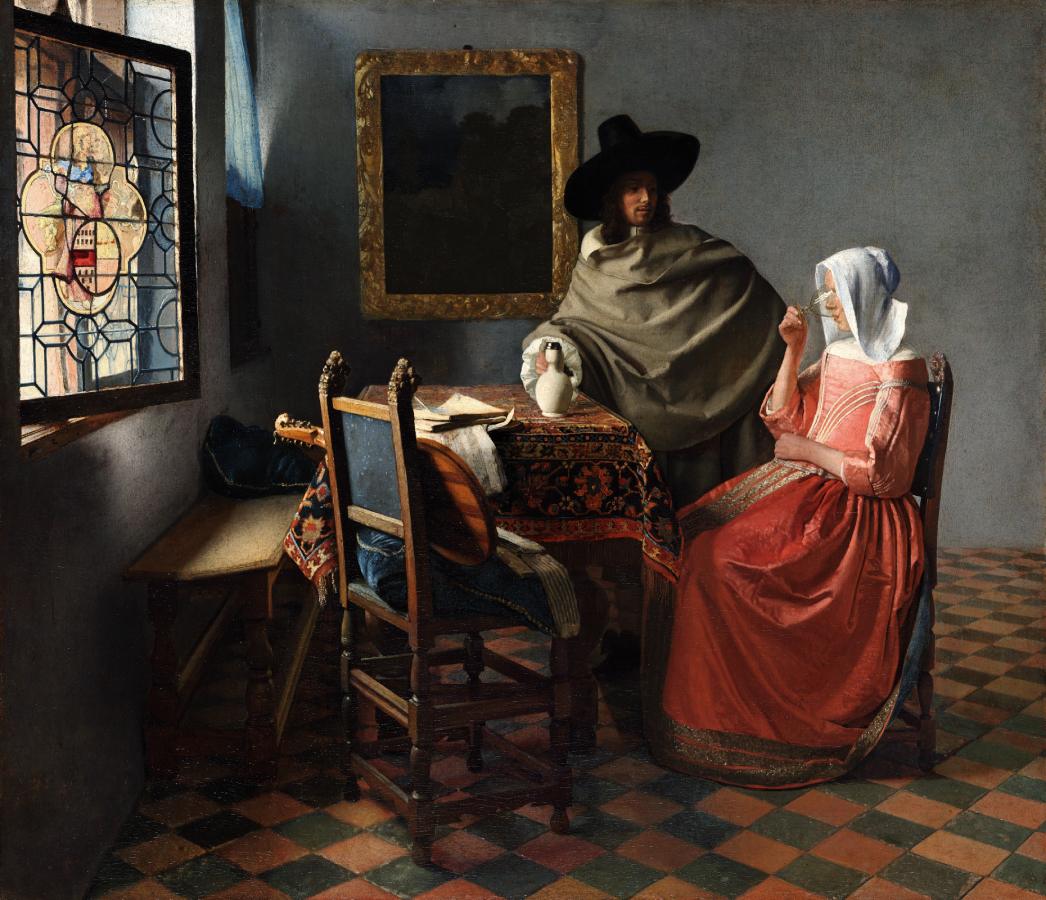Vermeer, Jan (1632-1675)
The Glass of Wine (Het glas wijn)
1658–1660
Oil on canvas, 67.7 x 79.6 cm
Gemäldegalerie, Berlin
In the reflection of cool daylight, which penetrates from the left, especially through the front of the two windows, a young woman sits at a table and drinks wine. She has turned the glass all the way down against her face, as if she wanted to escape the waiting gaze of the elegant cavalier, who is ready to be refilled, wine jug in hand, but without a glass of his own. An amorous relationship of dubious character has been initiated. Nevertheless, there is nothing coarse, nothing superficially erotic about the process.
On the chair and table, a cister and sheet music were set aside, possibly a reference to the couple’s music making music together. Vermeer transformed a common theme of Dutch genre painters. He may have been inspired by his fellow painter Gerard ter Borch, who also painted the motif of a cavalier with his hand on the bottle watching a lady drink. However, while the gentleman in ter Borch’s painting puts his arm around his lady’s shoulder, Vermeer provides no explicit reference to the nature of his couple’s relationship. Whether alcohol consumption will end in debauchery remains uncertain.
On the left, a slightly open window with a coloured coat of arms is depicted, on which a female figure with intertwined ribbons can be seen in her hand. A corresponding figure can be found among the emblems edited by G. Rollenhagen in 1617. The ribbons prove to be a bridle, an attribute of “temperance” (temperance) along with the angular measure. The accompanying text of the emblem reads: “Mens Servare Modum, rebus sufflata secundis, / Nescit, et affectus fraena tenere sui.” (The heart, when struck by the breath of happiness, does not know how to keep the measure and to put the restraint on the feelings.) This reference refers not only to the drinking of wine, but also to the relationship between the actors depicted and the foreseeable lack of restraint on the part of both. It is a warning to “keep the right measure”. In yet another painting, Vermeer used the depiction of this emblem in the same context. In the painting “Girl with a Wine Glass” (Herzog Anton Ulrich Museum, Braunschweig), however, the lewd advances of the gentleman are emphasized much more explicitly.
For the first time, the close-up view of things has been abandoned in the Berlin plant. Vermeer allows the viewer to step back by separating them from the empty chair at the table. The distance gained widens the viewing angle. The interior is no longer perceived as part of the figure section, but rather the figures are now part of the interior section. Innovations of this kind point to the influence of the first masterpieces of Pieter de Hooch, Vermeer‘s Delft painter colleague who was three years older. De Hooch’s interior depictions of the period around 1658 are primarily conceived and designed from the architecture of the interior. What Vermeer was able to make of an interior of de Hooch’s type, however, is made clear by the Berlin picture, which impresses with its strictly calculated structure, also with the illusionism of the painting style, which is preserved even in the differentiation of surface values, without exhausting itself in this purely factual determination. In the omnipresent light, things acquire the appearance of a higher quality. (Gemäldegalerie)
Compare:
 Vermeer, Jan (1632-1675)
Vermeer, Jan (1632-1675)
The Girl with the Wineglass
1658–1660
Herzog Anton Ulrich Museum, Braunschweig
